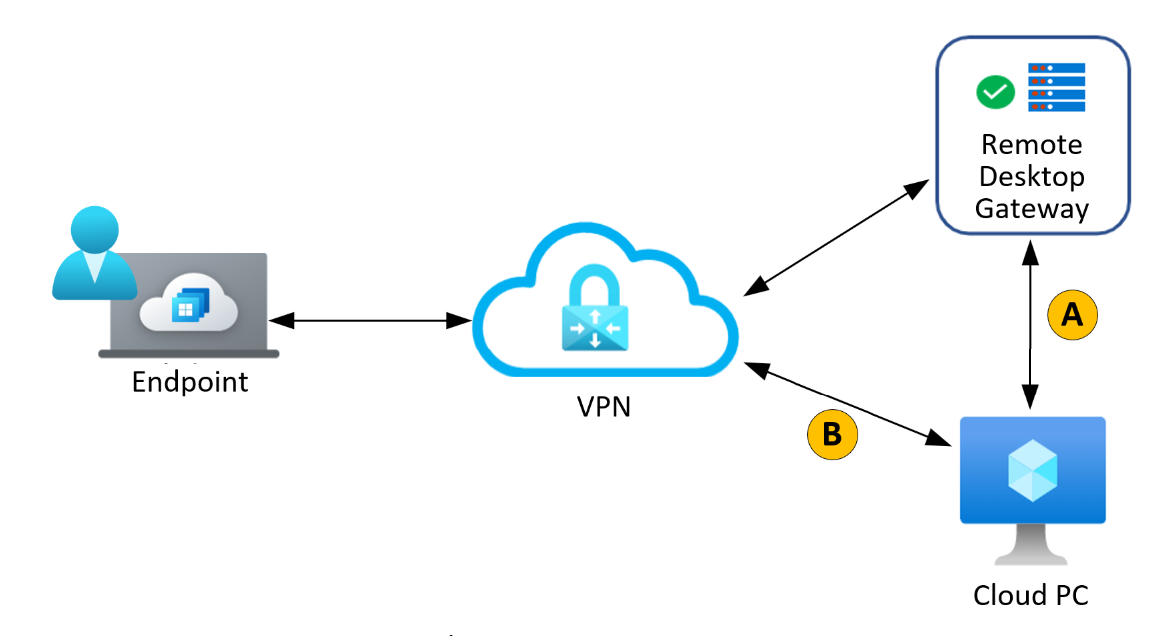Uso de RDP Shortpath para redes privadas con Windows 365
Puede usar Remote Desktop Protocol (RDP) Shortpath para redes privadas con los equipos en la nube de Windows 365.
Requisitos
Para usar RDP Shortpath para redes privadas con Windows 365, debe cumplir estos requisitos:
- Equipos en la nube aprovisionados en la red privada del cliente. Las redes privadas son compatibles con las conexiones de red de Azure. No se admiten redes hospedadas por Microsoft.
- Host de sesión (PC en la nube)
- Habilite un agente de escucha UDP en el puerto UDP 3390.
- Conectividad directa de línea de visión entre el cliente y el host de sesión. Esto significa que el cliente puede conectarse directamente al host de sesión en el puerto 3390 (valor predeterminado):
- Sin que los firewalls (incluido el Firewall de Windows) o el grupo de seguridad de red estén bloqueados.
- Uso de una red administrada como:
- Emparejamiento privado de ExpressRoute.
- VPN de sitio a sitio o de punto a sitio (IPsec), como Azure VPN Gateway.
Si usa otros tipos de VPN para conectarse a Azure, una VPN basada en UDP proporciona un mejor rendimiento. Aunque la mayoría de las soluciones de VPN basadas en TCP admiten UDP anidado, agregan una sobrecarga heredada del control de congestión tcp, lo que ralentiza el rendimiento de RDP.
Habilitación de RDP Shortpath para redes privadas
Para configurar y habilitar RDP Shortpath para redes privadas, visite la página de documentación de Azure Virtual Desktop y siga las instrucciones.
Ventajas de RDP Shortpath
La conectividad predeterminada a un equipo en la nube de Windows 365 es a través de una conexión TCP que atraviesa una puerta de enlace mediante el transporte de conexión inversa. El transporte inverso significa que no hay necesidad de conectividad entrante al host de sesión (PC en la nube) para conectar el tráfico RDP.
RDP Shortpath se basa en la conexión TCP y proporciona, cuando es posible, otra conexión directa entre el cliente de Escritorio remoto y el equipo en la nube de Windows 365. Esta conexión usa UDP como protocolo de transporte subyacente. Esta conexión UDP es una conexión directa a través de la red administrada por el cliente.

R. Después de la autenticación, se establece una conexión inversa de WebSocket mediante TCP a través del puerto 443.
B. UDP a través de una red privada mediante el puerto 3390. Si la conexión UDP se establece correctamente, la sesión RDP cambia a esta ruta de acceso.
Para obtener más información sobre las ventajas de RDP Shortpath, consulte Ventajas clave.
Proceso de conexión RDP Shortpath
Al usar RPD Shortpath, la conexión con el PC en la nube continúa de la siguiente manera:
- La conexión RDP establece una conexión basada en TCP mediante el transporte de conexión inversa a través de la puerta de enlace (de la misma manera que lo hace para la conectividad sin RDP Shortpath).
- El host de sesión envía la lista de sus direcciones IPv4 e IPv6 al cliente.
- El cliente inicia el subproceso en segundo plano para establecer un transporte paralelo basado en UDP directamente a una de las direcciones IP del host de sesión.
- Mientras el cliente está sondeando las direcciones IP proporcionadas, sigue estableciendo la conexión inicial a través del transporte de conexión inversa para asegurarse de que no hay ningún retraso en la conexión del usuario.
- Si el cliente tiene una conexión directa con el host de sesión, el cliente establece una conexión segura mediante TLS a través de UDP confiable.
- Después de establecer el transporte rdp shortpath, todos los canales virtuales dinámicos (DVC), incluidos los gráficos remotos, la entrada y el redireccionamiento del dispositivo, se mueven al nuevo transporte. Sin embargo, si un firewall o una topología de red impide que el cliente establezca conectividad UDP directa, RDP continúa con un transporte de conexión inversa.
Pasos siguientes
Para obtener información completa, consulte RDP Shortpath para Azure Virtual Desktop.